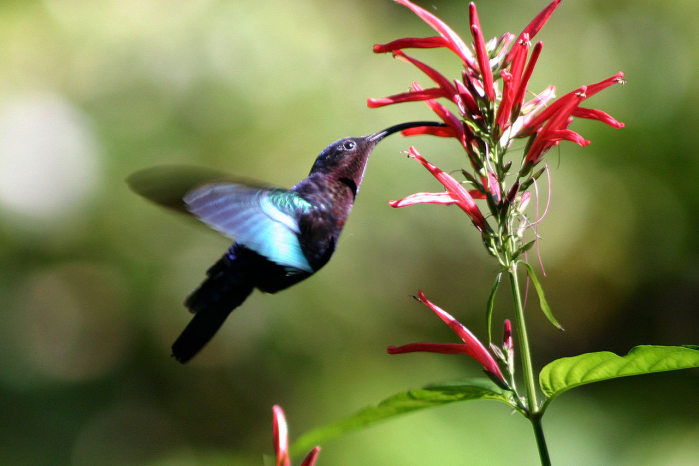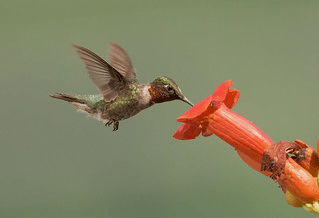Hummingbirds See Colors Over (Beyond) the Rainbow
Dr. James J. S. Johnson

The hearing ear, and the seeing eye, the LORD hath made even both of them. [ Proverbs 20:12 ]
God has equipped hummingbirds with a range of color vision that exceeds that of humans, so it’s fair to say that hummingbirds see over—or beyond—the rainbow.
This “beyond-the-rainbow” vision helps birds to see food, predators, nectar-producing plants, potential mates, and 3D objects within their physical environment. Recent research corroborates this amazing fact.(1),(2)
Humans have three types of color-sensitive cones in their eyes—attuned to red, green and blue light—but birds have a fourth type, sensitive to ultraviolet light. “Not only does having a fourth color cone type extend the range of bird-visible colors into the UV, it potentially allows birds to perceive combination colors like ultraviolet+green and ultraviolet+red—but this has been hard to test,” said [Dr. Mary Caswell] Stoddard. … Stoddard and her colleagues designed a series of experiments to test whether hummingbirds can see these nonspectral colors. Their results appear June 15 [2020] in the Proceedings of the National Academy of Sciences.(1)
[ see Princeton University citation below ]
Nonspectral colors are perceived when nonadjacent cone types (sensitive to widely separated parts of the light spectrum) are predominantly stimulated. For humans, purple (stimulation of blue- and red-sensitive cones) is a nonspectral color; birds’ fourth color cone type creates many more possibilities.(2)
[ see Stoddard , Eyster, et al. citation below ]

For years, literally, Dr. Stoddard and her team tested and quantified how wild hummingbirds see colors beyond the spectrum of white light that humans see.
To investigate how birds perceive their colorful world, Stoddard and her research team established a new field system for exploring bird color vision in a natural setting. Working at the Rocky Mountain Biological Laboratory (RMBL) in Gothic, Colorado, the researchers trained wild broad-tailed hummingbirds (Selasphorus platycercus) to participate in color vision experiments. … [using] a pair of custom “bird vision” LED tubes programmed to display a broad range of colors, including nonspectral colors like ultraviolet+green. Next they performed experiments in an alpine meadow frequently visited by local broad-tailed hummingbirds, which breed at the high-altitude site.(1)
[ see Princeton University citation below ]
The experiment was sweet, as one would expect with hummingbirds.(3)
Each morning, the researchers rose before dawn and set up two feeders: one containing sugar water and the other plain water. Beside each feeder, they placed an LED tube. The tube beside the sugar water emitted one color, while the one next to the plain water emitted a different color. The researchers periodically swapped the positions of the rewarding and unrewarding tubes, so the birds could not simply use location to pinpoint a sweet treat. … Over the course of several hours, wild hummingbirds learned to visit the rewarding color. Using this setup, the researchers recorded over 6,000 feeder visits in a series of 19 experiments.(1)
[ see Princeton University citation below ]

Stoddard’s team was particularly interested in “nonspectral” color combinations, which involve hues from widely separated parts of the color spectrum, as opposed to blends of neighboring colors like teal (blue-green) or yellow (green-red). For humans, purple is the clearest example of a nonspectral color. Technically, purple is not in the rainbow: it arises when our blue (short-wave) and red (long-wave) cones are stimulated, but not green (medium-wave) cones. While humans have just one nonspectral color—purple, birds can theoretically see up to five: purple, ultraviolet+red, ultraviolet+green, ultraviolet+yellow and ultraviolet+purple.(1)
[ see Princeton University citation below ]
Birds have four color cone types in their eyes, compared to three in humans. In theory, this enables birds to discriminate a broad range of colors, including many nonspectral colors. … We trained wild hummingbirds to participate in color vision tests, which revealed that they can discriminate a variety of nonspectral colors, including UV+red, UV+green, purple, and UV+yellow. Additionally, based on an analysis of ∼3,300 plumage and plant colors, we estimate that birds perceive many natural colors as nonspectral.(2)
[ see Stoddard, Eyster, et al. citation below ]
Also, the research team studied minute differences in color, as they are featured in plant material and bird feathers—there is a lot more to color that is appreciated by most human eyes!
Finally, the research team analyzed a data set of 3,315 feather and plant colors. They discovered that birds likely perceive many of these colors as nonspectral, while humans do not … [due to the birds’] four color-cone visual system.(1)
[ see Princeton University citation below ]
How colorful the world must be to hummingbirds!

Dr. Stoddard’s team were not the first to study the beyond-the-rainbow vision of birds. Previous studies have been reported, using finches and sparrows, indicating that diet is important for avian eyesight.
The ability of finches, sparrows, and many other birds to see a visual world hidden to us is explained in a study published in the journal eLife. Birds can be divided into those that can see ultraviolet (UV) light and those that cannot. Those that can live in a sensory world apart, able to transmit and receive signals between each other in a way that is invisible to many other species. … The study reveals two essential adaptions that enable birds to expand their vision into the UV range: chemical changes in light-filtering pigments called carotenoids and the tuning of light-sensitive proteins called opsins. Birds acquire carotenoids through their diets and process them in a variety of ways to shift their light absorption toward longer or shorter wavelengths.(4)
[ see PhysOrg citation below ]
If that seems complicated and mathematically challenging, it is!(4),(5)
The researchers characterized the carotenoid pigments from birds with violet vision and from those with UV vision and used computational models to see how the pigments affect the number of colors they can see. … The study also revealed that sensitivity of the violet/UV cone and the blue cone in birds must move in sync to allow for optimum vision. Among bird species, there is a strong relationship between the light sensitivity of opsins within the violet/UV cone and mechanisms within the blue cone, which coordinate to ensure even UV vision.(4)
[ see PhysOrg citation below ]

The more-technical description of the research is even more challenging, to read, but the implications are “clearly seen”—God has given birds amazing eyesight.
Color vision in birds is mediated by four types of cone photoreceptors whose maximal sensitivities (λmax) are evenly spaced across the light spectrum. … SWS1 [shortwave-sensitive cone] opsin is accompanied by a corresponding short-wavelength shift in the spectrally adjacent SWS2 cone.(5)
[ see Toomey, Lind, et al. citation below ]
Hummingbird eyesight is facilitated by some really technical details!
Here, we show that SWS2 cone spectral tuning is mediated by modulating the ratio of two apocarotenoids, galloxanthin and 11’,12’-dihydrogalloxanthin, which act as intracellular spectral filters in this cell type. We propose an enzymatic pathway that mediates the differential production of these apocarotenoids in the avian retina, and we use color vision modeling to demonstrate how … spectral tuning is necessary to achieve even sampling of the light spectrum and thereby maintain near-optimal color discrimination.(5)
[ see Toomey, Lind, et al. citation below ]
At the practical level, how can Christians benefit from knowing about avian eyesight? Or, what about other features—like wings, feathers, and motion-regulating software—that God has designed and installed into the world’s hummingbirds? Are we missing an opportunity to appreciate God if we ignore what He has done to enable hummingbirds to live as they do?

Hummingbird beaks, bones, and feathers differ from those of all other living or extinct bird kinds. Their wings don’t fold in the middle. Instead, they have a unique swivel joint where the wing attaches to the body so that the wings rotate in a figure-eight pattern. And they move fast! They have to beat their wings rapidly to hover, levitating with level heads as they extract nectar from flowers for hours per day. Scientists still need to discover the bird’s mental software that coordinates information about the location of a flower’s center with muscle motion that expertly stabilizes the hummingbird’s little head as it drinks.(6)
[ see Thomas citation below ]
Astonishing! What a stupendous and beauty-broadcasting imagination our God has—how can we see His busy, busy hummingbirds without admiring His technical genius and His bioengineering power?(7)
[ see Sherwin citation below ]
Yet every hummingbird alive today is a descendant from the originals made by God on Day 5 of Creation Week.
Their size, flight characteristics and patterns, metabolism, all point to our magnificent Creator who designed these amazing animals and created them on Day Five.(8)

References
- Staff writer, Princeton University. 2020. Spectacular bird’s-eye view? Hummingbirds see diverse colors humans can only imagine. PhysOrg (June 15, 2020), posted athttps://phys.org/news/2020-06-spectacular-bird-eye-view-hummingbirds-diverse.html .
- Stoddard, M. C., H. N. Eyster, et al. 2020. Wild Hummingbirds Discriminate Nonspectral Colors. Proceedings of the National Academy of Sciences (June 15, 2020), posted at https://doi.org/10.1073/pnas.1919377117 .
- Mitchell, E. 2014. Our Creator’s Sweet Design for Hummingbird Taste (Answers in Genesis: News to Know, September 6, 2014), posted https://answersingenesis.org/birds/our-creators-sweet-design-hummingbird-taste/ (with a link, in Footnote #1, to video footage of hummingbird sugar consumption).
- Staff writer, eLife. 2016. How Birds Unlock their Super-Sense, Ultraviolet Vision.PhysOrg (July 12, 2016), posted at https://phys.org/news/2016-07-birds-super-sense-ultraviolet-vision.html?utm_source=TrendMD&utm_medium=cpc&utm_campaign=Phys.org_TrendMD_1 .
- Toomey, M. B., O. Lind, et al. 2016. Complementary shifts in photoreceptor spectral tuning unlock the full adaptive potential of ultraviolet vision in birds. eLife Sciences / Biochemistry, Chemical Biology, Neuroscience (July 12, 2016), posted at https://elifesciences.org/articles/15675 ; doi: 10.7554/eLife.15675 .
- Thomas, B. 2016. Hummingbirds! Acts & Facts. 45(4), posted at https://www.icr.org/article/hummingbirds .
- Sherwin, F. 2006. Hummingbirds at ICR. Acts & Facts. 35(9), posted at https://www.icr.org/article/hummingbirds-at-icr .
- Dreves, D. 1991. The Hummingbird: God’s Tiny Miracle. Creation Ex Nihilo Technical Journal. 14(1):10-12.
Without a doubt — these little busy hummers are truly magnificent! And to think that God programmed them for such blurringly fast wingbeats!
LikeLiked by 1 person
AMAZING!!!
LikeLiked by 2 people
What magnificent little creatures! No wonder they are the favorites of many. And what an awesome God we serve. Such a privilege to know the master Creator! William
LikeLiked by 3 people